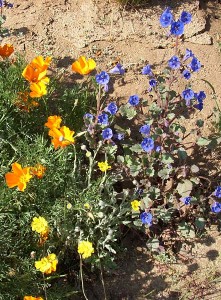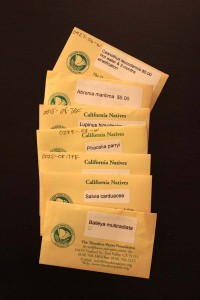The current house project reached a milestone, with us getting reaching the waterproof house wrap stage, ready for the siding. What this really means is that it’s no longer a race against the start of the fall rains to get this far. I can slow down a bit and get back to some things in the garden.
The cool, shortening work days signal that the fall planting season is approaching. As in the past I have new plants I’d like to try growing from seed. Consulting the really handy Seed Propagation of Native California Plants by Dara E. Emery, I see that the author recommends planting annuals by the end of October, and sowing lupines by October 15. So it’s really time to get myself in gear.
I’ve already received my order from Theodore Payne Foundation, mostly annuals, most of them plants that I looked at during the winter and spring blooming season and decided to try. I saw this plant combination at the Tree of Life Nursery on my last visit. I liked how the plants looked together, and added two of the three plants to my order: the gorgeous deep purple Parry’s phacelia, Phacelia parryi, and the perky yellow desert marigold, Baileya multiradiata. Another plant I scoped out on my spring treks was the stinging lupine, Lupinus hirsutissimus, and the Payne Foundation catalog had it. The pink, purple and yellow flowers of the three species should play well together. It won’t be anything too subtle, but what do you want out of springtime flowers?
Another interesting catalog, one that I’m looking at is Ginny Hunt’s Seedhunt. She’s got over forty sages from around the world, a dozen unusual restios from South Africa, and a nice representation of California natives. The latter include an attractive cream variant on the normally orange rancher’s fiddleneck, Amsinckia vernicosa var. furcata ‘Griswold Hills,’ along with some of the neat tarweeds, hemizonia, seven different clarkias, the less common Salvia carduacea, as well as the stinging lupine and Parry’s phacelia that I’ve already got.
Where many catalogs offer species and hybrid populations where the population’s traits have been fixed through several generations of selfing and sibling crosses, Seedhunt’s listing includes seed mixes of what appear to be open-pollinated agastaches and dahlias. If you have a sense of adventure mixes like this are a brave way to go. Because the exact pollen parents aren’t known, the plants that you get will show a certain amount of variation. The downside is that the plant size, exact flower color and maybe their size and shape your plants might not fit neatly with their neighbors in a manicured border. The fun part about this is that you’ll get a plant that’s not exactly like someone else’s. If you like adventure, this might be just the thing.
So this next week I hope to get at least some these seeds in pots or in the ground. It’ll be a great break from all the house projects. And Saturday the San Diego chapter of the California Native Plant Society is having their big plant sale of the year at Balboa Park. I’m not sure I’ll have time to plant a couple dozen new plants, but I’ll plan on checking things out and seeing what calls my name. There’s always time to look at plants.



My favorite thing to think about and do is collecting seeds for the next season. I lay awake last night thinking of the Tithonia that is flagging and needs pulling up: Should I gather more seed heads? Is a half gallon pitcher full enough? Tithonia is a favorite of butterflies here and I want them to have plenty next year. One plant grew so tall and wide that I had to support it with a steel fence post.
I should be out checking seeds in native plant areas now instead of writing here, which is my second fav thing to do, talk about seeds.
I hope your project turns out as anticipated.
Thanks for the heads-up on the plant sale at Balboa Park. I’ve been wondering why SD doesn’t have a nursery that specializes in natives and drought-tolerant plants. Everybody has some, but I want a whole nursery with nothing but!
I wonder which of our Restios are in your seed list?
Nell Jean, thanks for the wishes on the project! I can hardly wait to get back into the garden. I’d guess that a half gallon pitcher of tithonia seeds will make an incredible show next season. Are these the big orange ones? They’ll be able to see your garden from space! You have a spectacular year to look forward to.
George, I’ll definitely plan on being there, as early as I can get there. It’s a trudge to the closest native nurseries, all right. Escondido or San Juan Capistrano aren’t exactly close, though I try to hit them a couple trips per year.
EE, for this season I’m most interested in the drought-tolerant Rhodocoma arida. I have several plants of short-growing Thamnochortus from last fall’s sowings, mainly T. acuminatus, and I have a small clump of Chondropetalum tectorum that won’t remain small for long at its current growth rate… They’re great plants.
Rancho seeded the Baileya multiradiata a couple of years ago and they have been truly amazing. They seem to bloom constantly nearly all year – certainly during hotter half of the year.